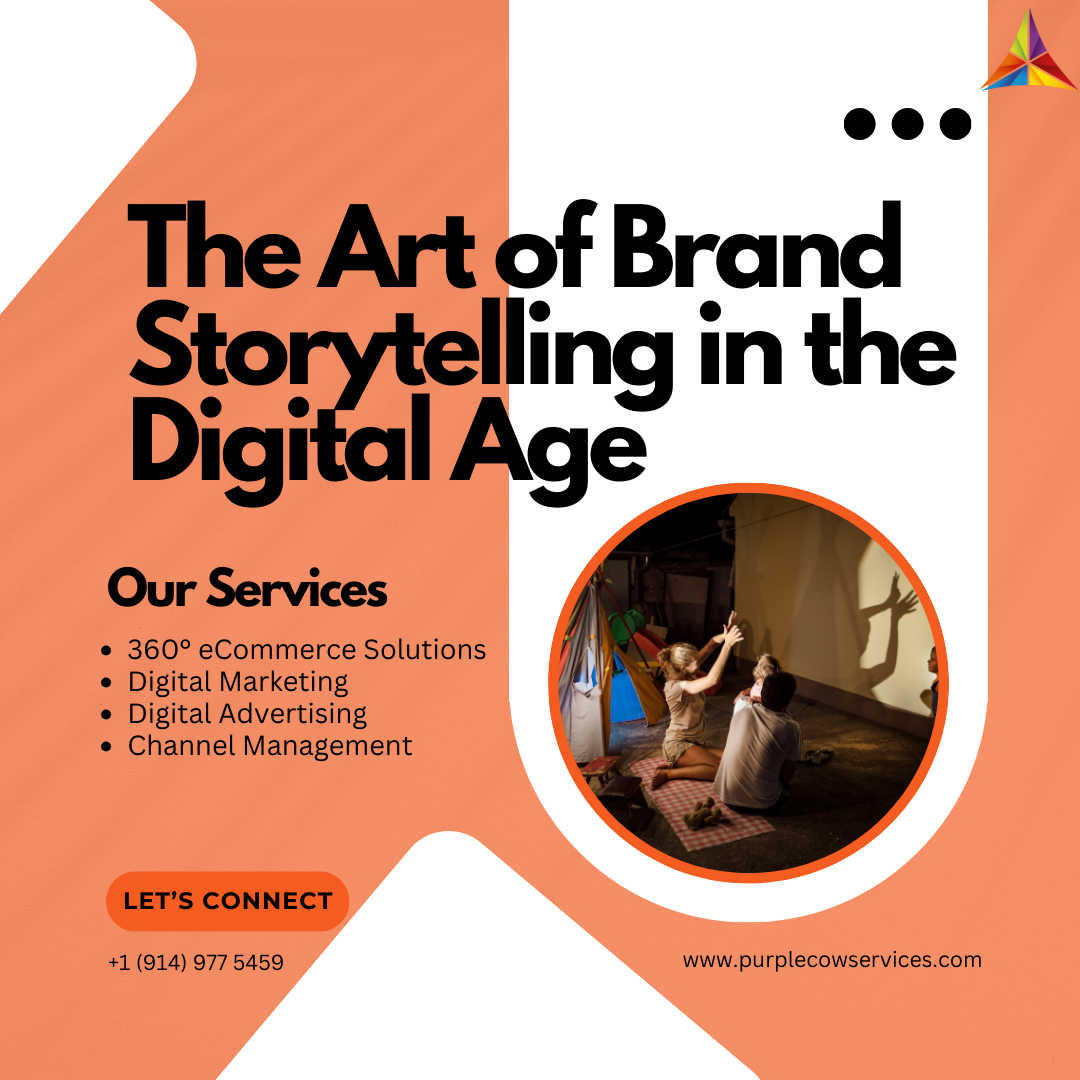In today's digitally-driven landscape, where information overload is the norm and consumer attention spans are fleeting, the art of brand storytelling has taken center stage.
Share This Story, Choose Your Platform!
It’s not merely a marketing technique but a profound way for brands to connect with their audience on a deeper, emotional level. In this era of constant digital noise, a well-crafted brand story has the power to cut through the clutter and leave an indelible mark in the minds and hearts of consumers.
Crafting a Compelling Narrative
At the heart of brand storytelling lies the crafting of a compelling narrative. This narrative is more than just a sequence of events; it’s a cohesive and immersive experience that draws the audience into the brand’s world. To achieve this, brands must identify their unique voice and perspective. What sets them apart in the digital landscape? What values and beliefs do they hold dear? These elements serve as the foundation upon which a captivating brand story is built.
The process begins with defining the brand’s core identity—its mission, vision, and values. These foundational elements provide the guiding principles for the narrative. For example, a brand that values sustainability and eco-conscious practices may weave these themes into its storytelling.
Crafting a compelling brand narrative also involves understanding the target audience. What are their needs, desires, and pain points? How can the brand’s story resonate with them on a personal level? Effective storytelling is about creating a narrative that feels tailor-made for the audience, addressing their aspirations and connecting with their emotions.
Connecting Emotionally with the Audience
In the digital age, where face-to-face interactions are limited, brands must seek alternative ways to create emotional connections with their audience. Storytelling offers a powerful solution. By sharing relatable stories and experiences, brands can evoke emotions such as empathy, nostalgia, or inspiration. These emotional connections foster brand loyalty and transform customers into brand advocates. In essence, effective brand storytelling in the digital age is about forging genuine and lasting bonds with the audience, transcending the transactional nature of commerce.
To illustrate, let’s consider a brand that specializes in artisanal, handcrafted products. Instead of simply showcasing its products, the brand can tell the story of the artisans behind the creations—their dedication, craftsmanship, and the cultural heritage that inspires their work. By doing so, the brand invites customers to connect not just with the products but with the people and stories behind them.
This emotional resonance extends beyond individual transactions. It fosters a sense of belonging and community. When customers feel emotionally connected to a brand, they are more likely to become brand advocates, sharing their positive experiences and stories with others. This word-of-mouth marketing, facilitated by brand storytelling, can be a potent driver of growth in the digital age.
Engaging Visual Storytelling
In the realm of digital content, visuals play a pivotal role in brand storytelling. The saying “a picture is worth a thousand words” holds true in the digital age, where attention spans are scarce. Incorporating captivating visuals, such as images, videos, and infographics, can enhance the narrative and make it more relatable. Visual storytelling allows brands to convey complex messages in a concise and engaging manner, catering to the preferences of modern digital consumers.
Consider the example of a travel brand. Instead of describing destinations in lengthy paragraphs, the brand can use stunning visuals to transport the audience to those places. High-quality images and videos can evoke the sights, sounds, and emotions of travel, allowing the audience to experience a glimpse of the brand’s offerings.
Visual storytelling also extends to the design elements of a brand’s digital presence. Consistent visual branding, including logos, color schemes, and typography, reinforces the brand’s identity and makes it easily recognizable. In the digital age, where consumers encounter countless brands daily, this visual consistency is vital for brand recall and differentiation.
Authenticity and Transparency
In an era of heightened consumer awareness and skepticism, authenticity and transparency are the cornerstones of effective brand storytelling. Audiences crave honesty and genuineness from the brands they engage with. It’s not just about telling a compelling story but also about being truthful and transparent about the brand’s values, practices, and impact. Authenticity resonates with consumers, building trust and credibility, which are invaluable assets in the digital age.
Authentic brand storytelling begins with aligning the brand’s actions with its words. If a brand touts its commitment to sustainability, it must demonstrate concrete steps taken toward sustainability, whether through eco-friendly production processes or partnerships with environmental organizations.
Transparency, too, plays a pivotal role. Brands should be transparent about their processes, sourcing, and any challenges they face. This transparency fosters a sense of honesty that resonates with consumers. It shows that the brand is not afraid to acknowledge imperfections and is committed to continuous improvement.
For instance, a cosmetics brand can be transparent about its ingredients, sourcing practices, and the steps taken to ensure product safety. By openly sharing this information, the brand builds trust with consumers who value transparency in their purchasing decisions.
Interactive Narratives and User-Generated Content
Digital platforms offer unique opportunities for interactive brand storytelling. Brands can engage their audience through interactive narratives, gamification, and user-generated content. These techniques not only make the storytelling experience more immersive but also encourage active participation from the audience. When consumers become active contributors to a brand’s story, they feel a stronger sense of ownership and connection, further solidifying their loyalty.
Interactive storytelling can take various forms. For instance, a fashion brand can create an interactive quiz that helps customers discover their personal style preferences and recommends products accordingly. This not only engages the audience but also provides valuable data for personalized marketing.
User-generated content is another powerful tool in the digital age. Encouraging customers to share their experiences, reviews, and creative uses of products on social media platforms can amplify the brand’s narrative. User-generated content serves as authentic testimonials, showcasing real customers’ stories and reinforcing the brand’s authenticity.
Measuring Impact and Iteration
In the digital age, data and analytics provide brands with insights into the impact of their storytelling efforts. Metrics such as engagement rates, social shares, and conversion rates offer a glimpse into how the audience is responding. Brands can use this data for continuous improvement and iteration of their storytelling strategies. The ability to adapt and evolve stories based on real-time feedback is a distinct advantage in the fast-paced digital landscape.
Engagement rates, for example, reveal how effectively the brand’s storytelling resonates with the audience. Are consumers actively interacting with the content, leaving comments, or sharing it with their networks? High engagement rates indicate that the brand’s storytelling is striking a chord with the audience.
Conversion rates, on the other hand, provide insights into how well the storytelling is driving desired actions, such as making a purchase or signing up for a newsletter. Brands can analyze conversion funnels to identify potential bottlenecks and optimize the storytelling elements that lead to conversions.
Data-driven decision-making is at the core of effective brand storytelling in the digital age. Brands can use A/B testing to experiment with different storytelling approaches and determine which resonates most with their audience. For example, a brand can test two variations of a product story—one focusing on its innovative features and the other highlighting its sustainability aspects. By analyzing the performance of these variations, the brand can refine its storytelling strategy for future campaigns.
The Global Reach of Digital Storytelling
One of the most remarkable aspects of digital brand storytelling is its potential for global reach. With the internet connecting people across borders, a well-crafted brand story can transcend geographical boundaries and resonate with audiences worldwide. This global reach opens up new horizons for brands to expand their presence and impact, reaching diverse cultures and demographics.
Digital platforms enable brands to tailor their storytelling to specific regions and demographics, ensuring relevance and cultural sensitivity. For instance, a brand’s narrative for a European audience may emphasize different cultural elements and values compared to its narrative for an Asian audience. This adaptability allows brands to connect with global audiences on a personal level, acknowledging their unique experiences and perspectives.
Conclusion
In conclusion, the art of brand storytelling in the digital age is a dynamic and ever-evolving endeavor. Brands that master this art can create lasting impressions, foster emotional connections, and build communities of loyal customers. From crafting compelling narratives to embracing authenticity and transparency, the digital landscape offers boundless opportunities for brands to shine through storytelling.
It’s not merely about conveying a message; it’s about inviting the audience on a journey—a journey where the brand and its audience share a story worth remembering. As the digital age continues to unfold, mastering this art remains a powerful tool for brands seeking to thrive in a rapidly changing world. Effective brand storytelling is the bridge that connects brands with their audience in a meaningful and memorable way, shaping the future of marketing in the digital age.
Unlock the Power of Digital Brand Storytelling with Purple Cow Agency!
Elevate your brand’s narrative in the digital age with our expert storytelling prowess. Craft compelling, authentic stories that captivate and engage your audience. From visuals that leave a mark to data-driven insights, we’re your partners in digital storytelling success. Join hands with Purple Cow and create a narrative that transcends boundaries, builds trust, and fosters brand loyalty. Let’s craft your digital story today!
Share This Story, Choose Your Platform!
In This Blog:
- Crafting a Compelling Narrative
- Connecting Emotionally with the Audience
- Engaging Visual Storytelling
- Authenticity and Transparency
- Interactive Narratives and User-Generated Content
- Measuring Impact and Iteration
- The Global Reach of Digital Storytelling
- Conclusion
- Unlock the Power of Digital Brand Storytelling with Purple Cow Agency!

















